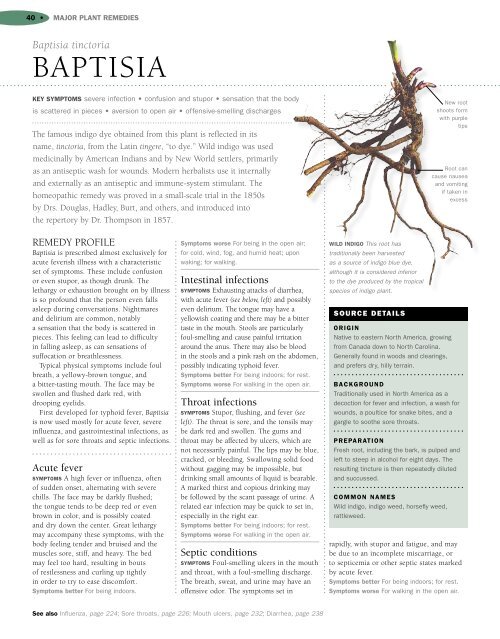Encyclopedia of Homeopathy
Encyclopedia of Homeopathy
Encyclopedia of Homeopathy
You also want an ePaper? Increase the reach of your titles
YUMPU automatically turns print PDFs into web optimized ePapers that Google loves.
40 •MAJOR PLANT REMEDIESBaptisia tinctoriaBAPTISIAKEY SYMPTOMS severe infection • confusion and stupor • sensation that the bodyis scattered in pieces • aversion to open air • <strong>of</strong>fensive-smelling dischargesThe famous indigo dye obtained from this plant is reflected in itsname, tinctoria, from the Latin tingere, “to dye.” Wild indigo was usedmedicinally by American Indians and by New World settlers, primarilyas an antiseptic wash for wounds. Modern herbalists use it internallyand externally as an antiseptic and immune-system stimulant. Thehomeopathic remedy was proved in a small-scale trial in the 1850sby Drs. Douglas, Hadley, Burt, and others, and introduced intothe repertory by Dr. Thompson in 1857.New rootshoots formwith purpletipsRoot cancause nauseaand vomitingif taken inexcessREMEDY PROFILEBaptisia is prescribed almost exclusively foracute feverish illness with a characteristicset <strong>of</strong> symptoms. These include confusionor even stupor, as though drunk. Thelethargy or exhaustion brought on by illnessis so pr<strong>of</strong>ound that the person even fallsasleep during conversations. Nightmaresand delirium are common, notablya sensation that the body is scattered inpieces. This feeling can lead to difficultyin falling asleep, as can sensations <strong>of</strong>suffocation or breathlessness.Typical physical symptoms include foulbreath, a yellowy-brown tongue, anda bitter-tasting mouth. The face may beswollen and flushed dark red, withdrooping eyelids.First developed for typhoid fever, Baptisiais now used mostly for acute fever, severeinfluenza, and gastrointestinal infections, aswell as for sore throats and septic infections.Acute feverSYMPTOMS A high fever or influenza, <strong>of</strong>ten<strong>of</strong> sudden onset, alternating with severechills. The face may be darkly flushed;the tongue tends to be deep red or evenbrown in color, and is possibly coatedand dry down the center. Great lethargymay accompany these symptoms, with thebody feeling tender and bruised and themuscles sore, stiff, and heavy. The bedmay feel too hard, resulting in bouts<strong>of</strong> restlessness and curling up tightlyin order to try to ease discomfort.Symptoms better For being indoors.Symptoms worse For being in the open air;for cold, wind, fog, and humid heat; uponwaking; for walking.Intestinal infectionsSYMPTOMS Exhausting attacks <strong>of</strong> diarrhea,with acute fever (see below, left) and possiblyeven delirium. The tongue may have ayellowish coating and there may be a bittertaste in the mouth. Stools are particularlyfoul-smelling and cause painful irritationaround the anus. There may also be bloodin the stools and a pink rash on the abdomen,possibly indicating typhoid fever.Symptoms better For being indoors; for rest.Symptoms worse For walking in the open air.Throat infectionsSYMPTOMS Stupor, flushing, and fever (seeleft). The throat is sore, and the tonsils maybe dark red and swollen. The gums andthroat may be affected by ulcers, which arenot necessarily painful. The lips may be blue,cracked, or bleeding. Swallowing solid foodwithout gagging may be impossible, butdrinking small amounts <strong>of</strong> liquid is bearable.A marked thirst and copious drinking maybe followed by the scant passage <strong>of</strong> urine. Arelated ear infection may be quick to set in,especially in the right ear.Symptoms better For being indoors; for rest.Symptoms worse For walking in the open air.Septic conditionsSYMPTOMS Foul-smelling ulcers in the mouthand throat, with a foul-smelling discharge.The breath, sweat, and urine may have an<strong>of</strong>fensive odor. The symptoms set inWILD INDIGO This root hastraditionally been harvestedas a source <strong>of</strong> indigo blue dye,although it is considered inferiorto the dye produced by the tropicalspecies <strong>of</strong> indigo plant.SOURCE DETAILSORIGINNative to eastern North America, growingfrom Canada down to North Carolina.Generally found in woods and clearings,and prefers dry, hilly terrain.BACKGROUNDTraditionally used in North America as adecoction for fever and infection, a wash forwounds, a poultice for snake bites, and agargle to soothe sore throats.PREPARATIONFresh root, including the bark, is pulped andleft to steep in alcohol for eight days. Theresulting tincture is then repeatedly dilutedand succussed.COMMON NAMESWild indigo, indigo weed, horsefly weed,rattleweed.rapidly, with stupor and fatigue, and maybe due to an incomplete miscarriage, orto septicemia or other septic states markedby acute fever.Symptoms better For being indoors; for rest.Symptoms worse For walking in the open air.See also Influenza, page 224; Sore throats, page 226; Mouth ulcers, page 232; Diarrhea, page 238
















